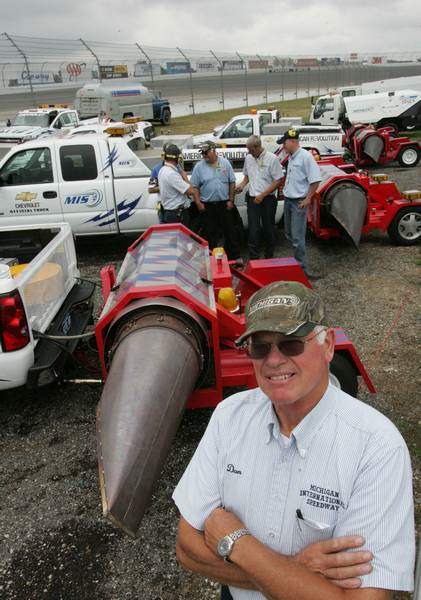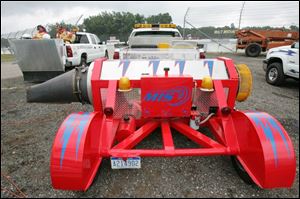
Track dries quick as a jet
8/25/2006
Dan Salenbien.

When rain threatens a race at Michigan International Speedway, specially equipped pickup trucks can dry the track quickly.
BROOKLYN, Mich. - They race when it's hot, they race when it's cold, and they race when it's anything and everything in between.
But absolutely no way, no how, no chance do they race when it's wet.
Forget about it.
So to keep Michigan International Speedway in business, even when there is rain to deal with, they needed to make the wet go away.
Enter some good, old-fashioned Yankee ingenuity, some military surplus, and that shop mentality of throwing the biggest tool in the box at a problem. That's why we had jet engines mounted on pickup trucks rolling around the racetrack this past weekend, quickly taking the surface from wet to dry, and the schedule from not racing to racing.
The jet dryers that put this two-mile track in a safe condition to hold Saturday's Carfax 250 Busch Series race were born at MIS, hatched from the creative mind of racing legend Roger Penske, and the mechanical genius of Dan Salenbien, the director of facilities at MIS for the past three decades.

Dan Salenbien.
In the early spring of 1978, after the track had recently been resurfaced, the work crew on site needed to get the snow out of a trench around the track so it could be filled with stone. A jet engine was brought out by the contractor and it did the job as Penske, the track owner at the time, looked on.
"Roger saw that, and said we needed something like that," Salenbien said. "I'm not going to take credit for it, because it was Roger's idea. Whenever he said 'can you do that?' I always said yes, and then went back to the shop and figured it out."
With surplus jet engines off military transport planes that they bought from the Arfons family, noted racing innovators, Salenbien gave Penske his track dryers. Those first J-34 Westinghouse engines, dated 1950, cost about $2,500. The ones Salenbien buys today are about $15,000.
"By the time we get them mounted on the truck, we probably have $60,000 in each one of these units," Salenbien said.
The rear-mounted jet dryers that do most of the work are attached on three-quarter ton dually pickups, while smaller, front-mounted jet dryers that Salenbien came up with to push debris away from the racetrack's walls are mounted on one-ton trucks.
"There was just a need to have something to ready the surface and eliminate the moisture, and these jet dryers are the answer we came up with," Salenbien said.
"With a little time to work, it allows us to race on days when that would be impossible, without the jet dryers."
"It was born out of a need, and jet dryers have allowed us to get the track back for racing so the fans can do what they come here to do - to see a race," MIS track president Brett Shelton said.
The jet dryers also rescued the Indy Racing League event in July after heavy rains postponed its start.
"Dan takes issues like this that stand in the way of events, and he finds solutions. That's his talent," Shelton said.
Salenbien, who is a native of Adrian and still lives there, came from a family that farmed and owned an excavating business. After working for eight years in an area gravel pit, he went looking for a new job when he learned the gravel operation would close.
"I had my last day there on a Friday, and my first day here at the track the next Monday," Salenbien said.
"I was always comfortable around machinery, so this job fit me. We needed a wrecker, so we built one. We never wanted to get caught short, so we just kind of figured out what we needed, and then came up with a way to do it."
Shelton said that despite the huge influx of money the sport has seen, it is still guys like Salenbien that make the race process work.
"Most of the people like Dan were here when we were still whitewashing fences and putting things together with bailing wire," Shelton said. "If something breaks, he'd find a way to fix it, and if there was a need for something, he'd come up with it. And it never came out of the shed with a big price tag on it."
MIS has seven jet-dryer trucks, one of the largest fleets in the country. The MIS trucks travel to races at other venues such as Talladega, Darlington and Richmond to supplement the on-site equipment.
The jet dryers run on high grade kerosene, just like jet airplanes use, and normally burn 200 gallons an hour. In the rush to get the track ready for the IRL race in July, all seven jet dryers were at work, and they burned close to 2,000 gallons of Jet-A fuel at close to $5 per gallon.
Contact Matt Markey at:
mmarkey@theblade.com
or 419-724-6510.